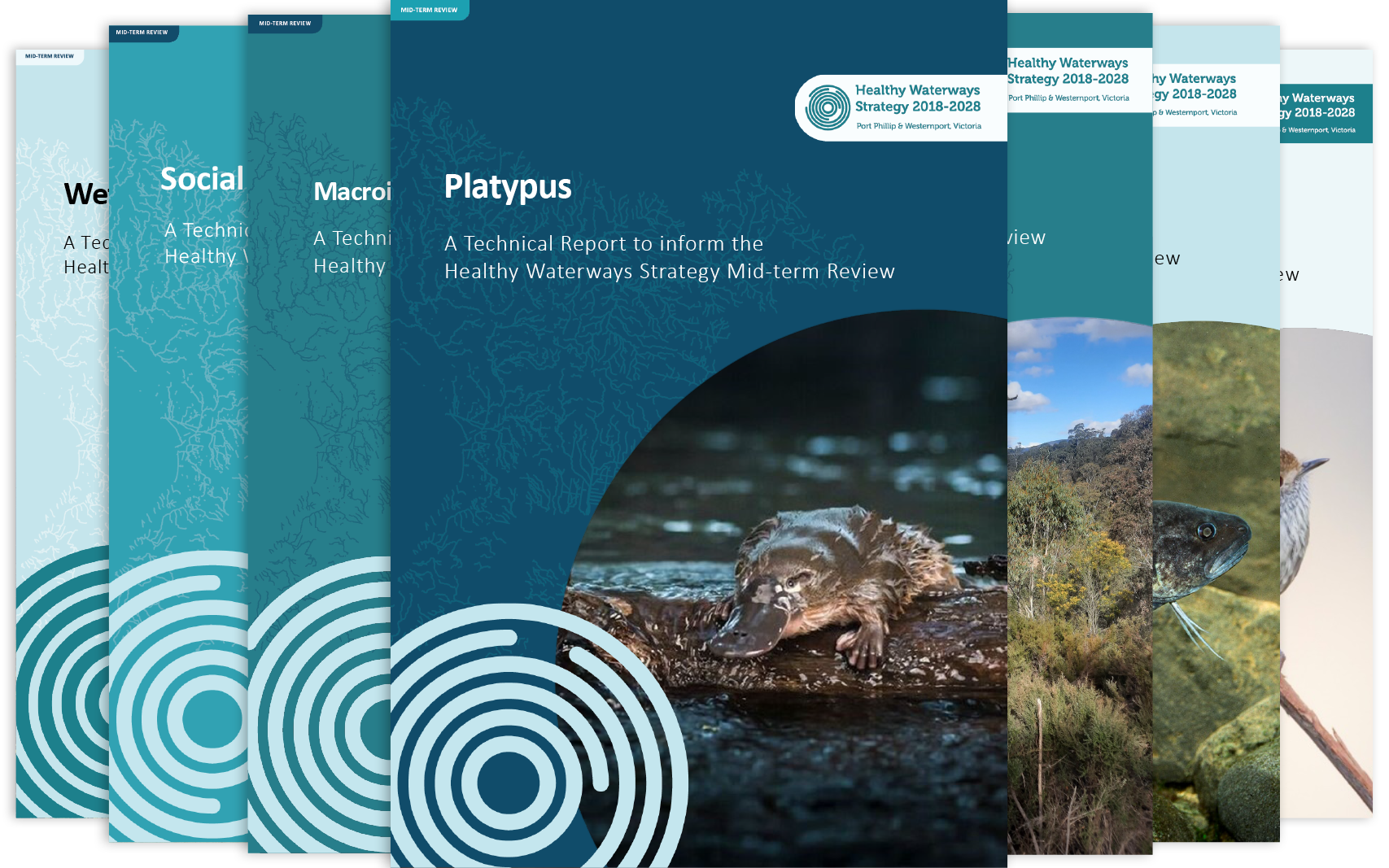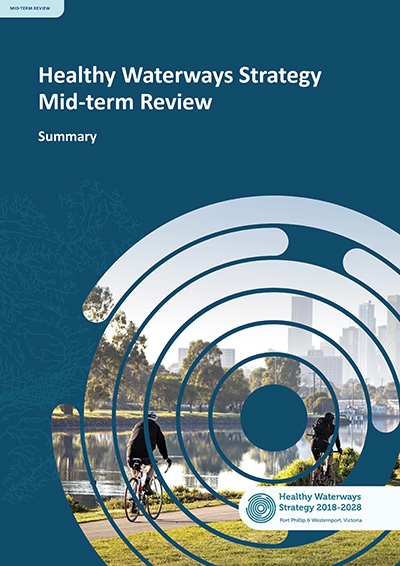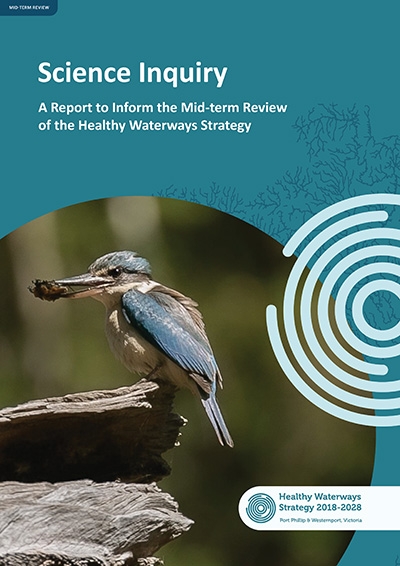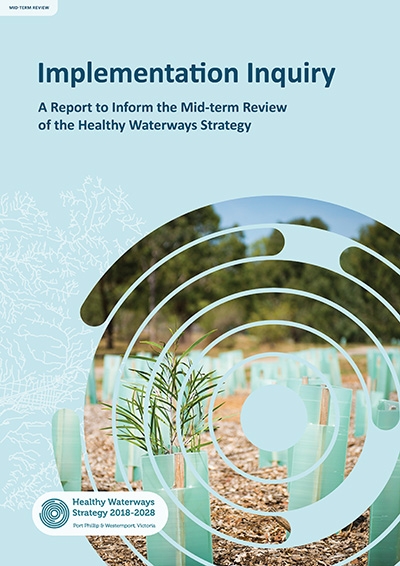The mid-term review of the Strategy is underway
The mid-term review commenced in 2022, assessing progress of the Strategy and identifying areas for improvement. It also looked at how external influences have changed since 2018 such as climate forecasts and new policies / guidelines, and how these changes may impact the ability to meet Strategy targets.
Mid-term review products
Summary
An interactive summary of the story of the Healthy Waterways Strategy so far and an overview of the findings and recommendations of the mid-term review.
Science Inquiry
To assess the trajectory of key values across the region, the state of current threats to waterway conditions and identification of knowledge gaps.
Implementation Inquiry
To assess progress and evaluate factors influencing implementation and the likelihood of meeting 10-year Performance Objective targets.
Technical reports

A series of technical reports evaluated the trajectory of key values and updated threats and knowledge about interventions to support the Science Inquiry as part of the mid-term review. Two of these reports outline the process and results from updating the models used to predict the impact of climate change and management interventions on the health of waterways with more recent data.
An independent Evaluation Panel was established to guide the review process and oversee development of the Science Inquiry and Implementation Inquiry reports. The Panel of waterway management experts led an evidence-based process, ensuring findings were robust and credible, in line with best practise evaluation. The Panel also provided an independent lens to prioritising recommendations.
While each inquiry had a specific focus, the Science Inquiry was conducted first and informed aspects of the Implementation Inquiry. For example, information about threats to waterway values identified in the Science Inquiry helped identify and prioritise high-risk sub-catchments requiring re-focused effort over the next few years to meet Performance Objectives.
Several key themes also emerged from the Science Inquiry that were further explored by the Implementation Inquiry, namely:
- Environmental impacts of increased impervious surfaces created from fast urban development, and the critical importance of meeting stormwater Performance Objectives.
- Long-term predicted climate change impacts on environmental conditions and values and what this means for the different Performance Objectives and focus areas, and
- Declining water availability and the need to better understand the level of impact and what this means for the water for the environment Performance Objectives.
Recommendations
The Science Inquiry and Implementation Inquiry identified recommendations which have been grouped into the following themes:
Findings
The mid-term review assessed the current Performance Objectives as sound and acknowledged the Healthy Waterways Strategy is making good progress in some areas. However, implementation is significantly off-track in others and requires refocused effort. The Science Inquiry and Implementation Inquiry have identified focus sub-catchments to guide collective effort and investment over the next five years, recognising there are constraints and limitations to delivering on all findings and recommendations across the region.
For example, rapid urban growth is leading to increased stream degradation and loss of natural wetlands (as identified in the Science Inquiry). Additionally, updated climate change modelling shows a greater potential threat than was predicted in 2018. Refocused effort around the Healthy Waterways Strategy Performance Objectives particularly for Stormwater, Natural Wetland protection and Water for the Environment is urgently required.
Recommendations at a glance
- Accelerate efforts in focus sub-catchments and wetlands. Detailed recommendations: S-4.1, S-4.2, I-1.1
- Align effort at all levels of management to overcome barriers to the challenging but critical, areas of Stormwater (including natural wetland protection), Water for the Environment and Vegetation. Detailed recommendations: I-1.2
- Prioritise interventions that have immediate outcomes (e.g. fishways for Lang Lang and Lower Werribee River and stormwater infiltration). Detailed recommendations: S-5.2, S-6.2, S-6.3, S-7.1, I-1.3
- Consider recognising efforts outside Performance Objective priority areas. Detailed recommendations: I-1.4
- Ensure adequate guidance is in place. Detailed recommendations: S-5.1, S-6.4, S-13.3, S-14.7, I-1.5
- Progress the integration of new knowledge to support implementation. Detailed recommendations: S-12.4, I-9.2
Use the links next to each recommendation above to view the specific findings and detailed recommendations in the Science Inquiry and Implementation Inquiry.
Findings
Support for the Strategy vision, targets and science remains strong across the delivery partners, including the desire to co-deliver with multiple collaborative projects underway that are contributing to the implementation of the Strategy. However, co-delivery is not being achieved to the extent intended, with limited evidence of any 'step-change' at a whole-of-Strategy scale. The mid-term review identified the need for Melbourne Water to strengthen its role as Strategy Lead, working with the Region-wide Leadership Group and delivery partners to deliver targeted initiatives focused on engagement, co-planning and co-delivery of the Healthy Waterways Strategy.
Recommendations at a glance
- Strengthen alignment across delivery partners, plans and strategies. Detailed recommendations: I-2.1
- Clarify accountabilities with partners to progress critical Performance Objectives (e.g. Water for the Environment and Stormwater). Detailed recommendations: I-2.2
- Collaborate across multiple scales and focus on at risk Performance Objectives and complex region-wide issues. Detailed recommendations: I-2.3, I-2.4, I-4.8
- Celebrate leaders and embed a culture of knowledge sharing, collaboration and learning. Detailed recommendations: I-2.5, I-2.6
- Improve and streamline Melbourne Water systems and processes to drive co-delivery. Detailed recommendations: I-2.7
Use the links next to each recommendation above to view the specific findings and detailed recommendations in the Science Inquiry and Implementation Inquiry.
Traditional Owners have lived in this region for tens of thousands of years and have connections with the landscape and waterways through significant places, artefacts, language, stories and traditions.
The Healthy Waterways Strategy commits to working with Traditional Owners and Aboriginal Victorians to protect and promote their cultural and historical connections with waterways. It also aims to protect the environmental values (land, water, vegetation and wildlife) which underpin these connections and share knowledge and understanding about waterways and their catchments.
The assessment of the Healthy Waterways Strategy’s progress towards cultural values objectives will be completed by Traditional Owners through a separate process which will reflect on the past five years through the projects implemented and the context of changed policy around water and Traditional Owners - notably Water is Life, the Burndap Birrarung burndap umarkoo (Yarra Strategic Plan), Waterways of the West Action Plan, and Central and Gippsland Region Sustainable Water Strategy.
This process aims to develop a path forward, supporting self-determination over the next four years of the Strategy and beyond.
The mid-term review provides a platform to progress this outside the Implementation Inquiry, Science Inquiry and formal response.
Recommendations
- Understand the aspirations and expectations of Traditional Owners in the protection and management of waterways as part of implementing and evaluating the Healthy Waterways Strategy and Water is Life (e.g. evaluation of cultural Performance Objectives and identification of appropriate indicators). Detailed recommendations: I-3
- Collectively support Traditional Owners in their work to assess the health of Country and, where Traditional Owners deem is appropriate, integrate this knowledge into end of Healthy Waterways Strategy evaluation process and continued implementation of the Strategy. Detailed recommendations: S-3.1
Use the links next to each recommendation above to view the specific findings and detailed recommendations in the Science Inquiry and Implementation Inquiry.
Findings
Since 2018, urban development has led to an estimated 1,700 hectares of additional impervious surfaces (which is more than 50% of the total expected by 2028). This increase is predicted to contribute to the decline of macroinvertebrates in at least 12 sub-catchments. Protecting waterways from the impacts of stormwater requires new approaches to urban planning and construction that reflect the latest knowledge, guidelines and practice standards. Managing pollution sources such as sediment and pesticide run-off from construction and impacts from industrial areas also needs to be addressed to maintain good quality water.
Changes to stormwater guidance in recent years provide the foundations for progressing stormwater performance objectives, however works are yet to be substantially realised on-ground. The issue of stormwater management is complex and must involve multiple organisations and industries to drive meaningful change. Healthy Waterways Strategy Partners, including Melbourne Water must urgently work together to prevent waterway degradation from urban development by accelerating on-ground outcomes to achieve stormwater targets and deliver on existing commitments.
Recommendations at a glance
- Clarify roles and responsibilities within Melbourne Water and across delivery partners for stormwater harvesting and infiltration. Detailed recommendations: I-5.5
- Clarify implementation pathways for the new EPA stormwater guidance. Detailed recommendations: S-13.1, I-5.5, I-5.7
- Build industry capacity for managing stormwater volumes. Detailed recommendations: I-5.8
- Take an 'action learning' approach to accelerate infiltration and harvesting projects. Detailed recommendations: I-5.1, I-5.2, I-5.3
- Increase coordination across aligned plans(e.g. Central and Gippsland Region Sustainable Water Strategy and Integrated Waterway Management Catchment Plans). Detailed recommendations: I-5.4, I-5.6
- Reduce the impacts of contaminants from key activities (e.g. improve control measures for industrial areas and construction phases). Detailed recommendations: S-12.2, S-12.3, S-12.4, S-12.5, I-6.1, I-6.2, I-6.3, I-6.5, I-6.6
Use the links next to each recommendation above to view the specific findings and detailed recommendations in the Science Inquiry and Implementation Inquiry.
Findings
The Healthy Waterways Strategy marks a significant improvement in how natural wetlands have been planned for and managed, with specific Performance Objectives set for a range of natural wetlands in the region. Despite this, several important natural wetlands have been lost due to urbanisation. Headwater streams have also been more clearly recognised in the Strategy for their importance in the overall waterway network but are equally threatened by urban development.
In response to the first Healthy Waterways Strategy Annual Report (2020), which reported natural wetlands as lost or under imminent threat, the Region-wide Leadership Group requested a discussion paper articulating the problem, the policy and planning context, and options for improved management. However, five natural wetlands have effectively been lost to urban development since 2018. While delivery partners strive to improve protection of natural wetlands and headwater streams, the rate of loss continues (14 natural wetlands are currently under imminent threat), and urgent effort is required to address this.
Recommendations at a glance
- Investigate and implement new options to protect wetlands and headwater streams under imminent threat from urban development. Detailed recommendations: S-14.2, S-14.6, S-14.7, I-7.1, I-7.4
- Strengthen wording of relevant Performance Objectives to promote better protection of wetlands. Detailed recommendations: S-14.1, I-7.2
- Increase adoption and use of updated mapping of wetlands and headwater streams for planning. Detailed recommendations: S-14.3, S-14.4, I-7.3, I-7.6
- Improve policies and planning frameworks through the next Victorian Waterway Management Strategy. Detailed recommendations: S-14.5, I-7.5
Use the links next to each recommendation above to view the specific findings and detailed recommendations in the Science Inquiry and Implementation Inquiry.
Findings
There is an urgent need to progress environmental water recovery and improve outcomes in regulated and unregulated systems. However, managing competing water needs is a complex issue, especially in a drying climate. The mid-term review found some declines in waterway values are likely to be linked to declining water availability and despite efforts, little progress has been made to date in achieving water recovery targets set in the Strategy.
Many initiatives are underway, however greater commitment to securing appropriate environmental flows across both regulated and unregulated systems is required. Strategies and plans such as Central and Gippsland Region Sustainable Water Strategy and Catchment Scale Integrated Water Management Plans support the need for increased water for the environment and offer an opportunity to collaborate on delivering on-ground outcomes.
Recommendations at a glance
- Prioritise securing an environmental water entitlement for the Maribyrnong River catchment. Detailed recommendations: I-4.1
- Increase of the substitution of manufactured water to drive water recovery across all catchments (e.g. use of harvested stormwater and desalination instead of diversion from waterways). Detailed recommendations: S-4.1, I-1.2, I-4.3, I-4.4
- Ensure environmental water representatives are more involved in water resource planning. Detailed recommendations: I-4.2
- Improve consistency between Melbourne Water and Southern Rural Water in the use of existing flow protection mechanisms (e.g. metering, bans and rosters etc). Detailed recommendations: I-4.5, I-4.6
- Explore and implement new approaches for managing stream flow in light of updated climate projections (e.g. farm dam management). Detailed recommendations: S-11.1, I-4.7
Use the links next to each recommendation above to view the specific findings and detailed recommendations in the Science Inquiry and Implementation Inquiry.
Findings
Working with private landowners is critical to achieving Healthy Waterway Strategy outcomes, particularly along waterway frontages in focus sub-catchments where vegetation establishment targets are significantly off-track. There is a need to increase investment and engagement with private landowners and establish new approaches that support integrated catchment and waterway management outcomes. Deer have been identified as an increasing threat to vegetation. Deer management in remote forested areas has also been identified as particularly challenging.
Delivery partners (including landowners) need to work together, to coordinate efforts to protect high quality vegetation sites.
Recommendations at a glance
- Find new ways of engaging with private landowners and overcoming barriers to improving waterway vegetation (e.g. working together on vegetation management and deer control). Detailed recommendations: I-8.1, I-8.2, I-8.3
- Increase coordinated, broad-scale, multi-agency approaches for working in remote areas. Detailed recommendations: S-6.1, I-9.1, I-9.3, I-9.4
- Improve reporting on works funded from outside Melbourne Water. Detailed recommendations: I-8.4
Use the links next to each recommendation above to view the specific findings and detailed recommendations in the Science Inquiry and Implementation Inquiry.
Findings
Supporting the social values of waterways is increasingly recognised as an important component of waterway management. Community expectations around access to greenspace and the ability to connect with nature through recreation or volunteering has grown in recent years recognising the mental health and wellbeing benefits it can provide. Connecting with nature is also known to increase community awareness, appreciation and action to protect environmental values. The presence of litter impacts the value of a waterway from an environmental and social perspective and is seen by the community as a key threat to waterway health. Litter management is complex because it requires multi-agency interventions and coordination. While there is consensus on the importance of litter management, a commitment to action is required.
Recommendations at a glance
- Progress the social values framework and ensure wetlands are adequately recognised. Detailed recommendations: S-10.1, I-10.3
- Improve the ability to evaluate progress towards social value outcomes. Detailed recommendations: S-10.3, S-10.5
- Improve waterway access in focus sub-catchments. Detailed recommendations: S-10.2, I-10.2
- Support community group participation in waterway management. Detailed recommendations: I-10.1
- Prioritise areas for litter management by expanding the new litter monitoring method and progressing the development of solutions. Detailed recommendations: S-10.4, I-11.1, I-11.2, I-11.3
- Continue to investigate recreational water quality risks. Detailed recommendations: I-6.4
Use the links next to each recommendation above to view the specific findings and detailed recommendations in the Science Inquiry and Implementation Inquiry.
Findings
This is the first time a comprehensive mid-term review of the Healthy Waterways Strategy has been conducted. The ability to undertake this review has relied on data collected through improved annual reporting, monitoring programs and external evaluation. Being able to track and evaluate the Strategy's progress is important to ensure changes and improvements can be implemented efficiently and in a timely manner. While enhancements to monitoring and reporting programs have been made, there is a need to ensure continuous improvement and that remaining gaps are addressed, and data management system continue to develop.
Recommendations at a glance
- Continue to improve data capture and management systems. Detailed recommendations: I-12.1
- Update specific targets identified through this the mid- term review. Detailed recommendations: S-7.2, S-8.3, S-9.1, S-14.1, I-7.2, I-12.3
- Address knowledge gaps and improve monitoring and evaluation methods to inform final review process. Detailed recommendations: S-1.1, S-8.1, S-8.2, S-11.1, S-12.1, S-14.8, I-6.6, I-12.4, I-12.5
Use the links next to each recommendation above to view the specific findings and detailed recommendations in the Science Inquiry and Implementation Inquiry.
Next steps
Over the coming months, Melbourne Water and the Region-wide Leadership Group will host a series of forums to share findings and recommendations from the mid-term review and collaborate with delivery partners to develop a response to the recommendations.
These forums are an opportunity for delivery partners to work together to re-assess where we collectively need to focus effort and what work needs to be prioritised, as well as consider new ways of achieving Strategy targets and Performance Objectives.


